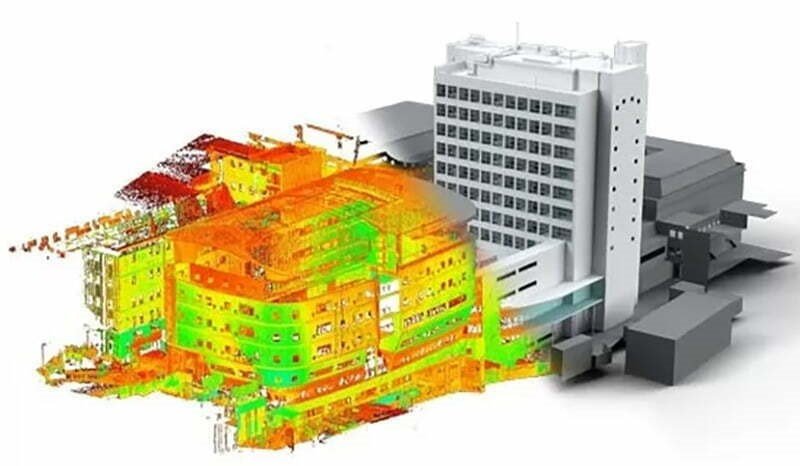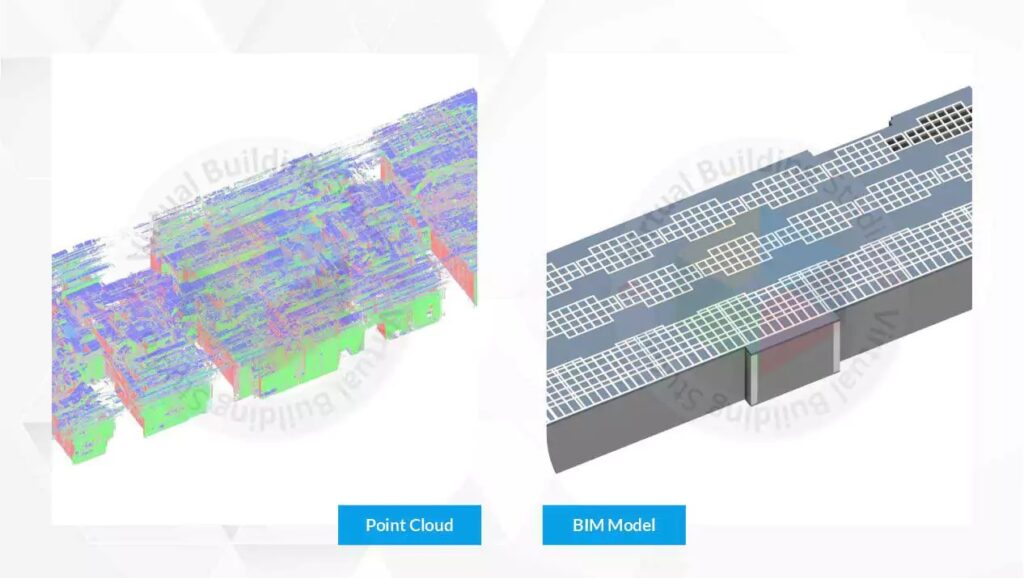Building Information Modeling (BIM) is a standardized method of visualizing spaces in a three-dimensional space. With the use of information and communication technology, it can play an effective role in building maintenance and operation. Scan to BIM Modeling services translate to the services catering to building analysis and data documentation using a Laser Scanner. Laser scanning is an evolving technology of the AEC industry that allows quick, accurate, and comprehensive 3D models of structures and their neighborhoods.
What is Scan to BIM?
Scan to BIM is a process of generating a 3D BIM from a laser scan of an existing structure. The laser scanner captures millions of data points that are combined to form a point cloud. A point cloud is a combination of data points within a three-dimensional coordinate system. The axes represent the external surface of an object.

Laser scanning devices like mobile mapping systems and terrestrial laser scanners can capture millions of measurements and collect information about the built environment. All the data is combined and represented in a virtual format called Point Cloud. There are numerous devices available in the market providing a certain level of quality and accuracy required to generate point clouds. Scan to BIM Modeling services cater to the structural analysis of the building, analysing and identifying the structural issues.
Multidisciplinary converging technologies are responsible for notable developments such as safety inspections and Scan to BIM. With the development of scanning technology, the demand for BIM Modeling services is growing. A permanent visual record of the project is developed using images generated with digital photogrammetry. It is relatively inexpensive and highly accurate with rapid and three-dimensional data availability.
Building Analysis with Scan to BIM Modeling Services
A significant advantage of Scan to BIM is that it is an effective tool for a comprehensive Building Analysis. The 3D model developed from the scans produced with the laser scanner helps the stakeholders identify potential structural issues, such as deformations, cracks, or any other irregularities that are not visible to the naked eye.

The Scan to BIM services allow to conduct a non-invasive analysis of the structure. Non-invasive analysis refers to a non-destructive or reformative building inspection, which can be time-consuming and expensive. The building analysis helps the architects and engineers study the structure from all existing angles and recognize hidden structural issues.
3D Laser scanners are being employed in various types of structures with the technology advancement over time. The evaluation system with a 3D laser scanner performs safety inspection through 3D models and imagery. This evaluation system helps in documenting building information with a status assessment conducted using the image data. To evaluate the structural deformation and deflection, 3D Modeling was executed using PCD.
The inspection of aging buildings can be conducted using Scan to BIM at a faster pace and with utmost accuracy without even referring to the building drawings. These services enable the evaluation of a deflecting slab or a deformed column.
BIM Modeling plays a vital role in the building analysis process offering several advantages:
– Data Accuracy
Scan to BIM Modeling services use laser technology that captures millions of points with utmost precision. The point cloud documents every site component from all possible angles enhancing the accuracy of the resulting model.
– Clash Detection
The BIM model is infused with point cloud data for clash detection using Scan to BIM services. This process detects potential conflicts and errors between structural systems or elements. Identifying these clashes at an early stage helps in cost savings during the time of construction or renovation.
– Information-rich models
The 3D models created with BIM are rich with information about materials, structural components, dimensional details, structural load details, energy efficiency, and climate analysis. This data is invaluable while dealing with structural issues. The details about every building’s nuance also provide an understanding of the building’s composition.
– Structural Assessment
Structural engineers and analysts can conduct thorough building assessments to identify weaknesses, load-bearing issues, or structural anomalies with a detailed BIM model. These examinations are crucial to ensure the integrity and safety of the structure.
– Comprehensive Visualization
The 3D BIM model provides a holistic and detailed view of the building. This inclusive visualization of the structure allows for a thorough examination of the structural details. The analysis formulates grounds for the analysts to identify issues that might not be detectable from the drawings or the on-site inspection alone.
– Foundation and Settlement analysis
BIM modeling services cater to every aspect of building analysis. It is highly convenient for foundation and settlement analysis. The comparison between the as-built conditions with the original design highlights the areas where the building has settled or shifted. The comparison enables the analysts to articulate potential measures to mitigate these problems.
– Historic Preservation
The historic buildings do not have documented drawings or information to refer to for preservation purposes. Scan to BIM Modeling meticulously captures the building’s as-built conditions, facilitating the planning and execution of restoration work while preserving its architectural significance.
– Reduced risks, time spent, and project costs
The building analysis with Scan to BIM allows the identification of structural issues early, helping to mitigate risks and reduce the overall costs linked to unforeseen situations during construction. It allows the project team to address such issues before they escalate and reduce the completion time of the project.
– Better Collaboration and Communication
The BIM process promotes collaboration among the project stakeholders. Access to the 3D model by everyone allows for unfiltered communication to develop a seamless design. The clear discussion allows them to make informed decisions and find appropriate solutions for the existing issues.
Conclusion
Scan to BIM serves as a powerful tool for building analysis and structural design. Architects and engineers can create more comprehensive designs by identifying potential structural issues through a 3D model created with laser scanning technology.
This technology is transforming the architecture and construction industry by facilitating building analysis and design. Stakeholders at all stages of a project – project managers, architects, surveyors, engineers, interior designers, and other consultants, can advertently collaborate and benefit from the Scan to BIM Modeling services.